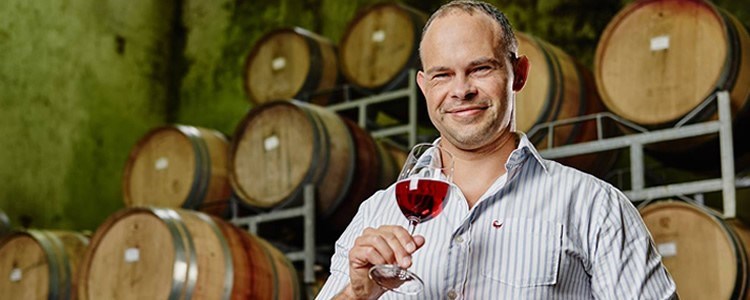Some wines are blends of dozens of components, be it rows of vines or blocks of vines or altitudes, aspect, age of vines, harvest date, farms or regions. At the cellar more blending occurs, of grape batches, of yeasts, of tanks, of barrels and so on. Another layer of complexity is added when marrying varietals for blends together.
So how on earth does a winemaker do it?
Gerhard Swart, Chief Winemaker for Accolade Wines SA, winemaker at Flagstone, (part of Accolade Wines SA) and winner of multiple awards, is a good person to ask. His job entails making the Flagstone range, and overseeing the Kumala, Fish Hoek and Dragon’s Back Mountain Range and he and his team deal with millions of litres of wine each year.

Commercial wines are often bought as finished wine from dozens of sources and contracted growers and Gerhard signs off on each brand after lengthy selection processes at several production centres.
The premium wines under the Flagstone label, though, provide the best example of the art of selecting and blending.
We used the acclaimed Music Room Cabernet Sauvignon as an example. Selection of grapes comes first, relying on knowledge of vines and vineyards built up over years and good relationships with growers. Gerhard deals with more than 15 growers, with some 40-50 blocks of vines. Over 10 years Gerhard has learnt the facets of each vineyard, has a close understanding with growers and together they agree on pruning regime, canopy management, green harvesting, irrigation, and with frequent visits – maybe even eight visits a year to the same block (he covers 20000km driving to vineyards) he knows the performance of each block and he uses the same vineyards 90% of the time. For the Music Room Gerhard uses farms in four regions and five blocks of vines. He might use three different pickings from an Elgin vineyard as it climbs a slope, filling six 3ton open top fermenters. From another region he has another three batches from one block. Yield will be agreed, harvesting procedure agreed (often spread over six weeks due to different ripening times across regions), and all blocks are tasted before picking by an anxious Gerhard, before dawn and into the evening. In total maybe 15 batches will arrive at Flagstone, enough for some 100 barrels (for the Music Room).
Each batch gets its own tank (more than 50 in total in the winery), some 1000litre, some much larger, and after 5 years experimenting with matching yeasts for each vineyard Gerhard will eventually send some 50 barrels of Music Room for 18 month maturation. Gerhard is still testing oak barrels; different producers, different forests, different stave drying times, different toasts, and will select specific barrels for each vineyard. Gerhard uses varying proportions of French, US and Hungarian oak for his top reds, some with 30% new wood, some with 10% adjusted by adding or subtracting the amount of the batch going into a new barrel. Each barrel is numbered and labelled with the vintage, farm and block, variety, and from which tank. During maturation, Gerhard will taste samples of each batch every six to eight weeks, some 120 samples, plotting its development, comparing analysis to volumes of comparative data he has acquired over previous vintages, and projecting its future, any batch that isn’t right goes to another brand. Tasting is often with the team and blind and after 12 tastings of each batch final selections are made. For 18 months barrels are monitored, adjustments might be made to selection or racking, stabilising and finishing and when all is just as the team want it, bottling commences.
And that is it, a new vintage of Music Room Cabernet Sauvignon. It only took dozens of visits to vineyards from Wellington to Elim (“I am used to driving to Robertson at 5am”, says Gerhard), constant meetings with growers and his winemaking team, scores of tastings from the vineyard to bottling, hours of record keeping, choices of batches, tanks, yeasts, barrels, finishing procedures and moment of bottling.
For blended varietal wines another layer of decisions is added. His Longitude, Dragon Tree and Treaty Tree blends require all of the above, plus sample analysis requiring monitoring the potential harmony and balance of varieties when added together. The ratio of one to another is key. Sample tastings have to consider proportions, such as the Dragon Tree which in 2015 ended with 40% of Pinotage, 30% Shiraz and smaller amounts of Cabernet Sauvignon and Malbec. The possible permutations of each varietal in the blend is considerable and a hugely important decision to make. Tasting analysis is not just about marrying tank, yeasts and barrels, but for blends selecting particular batches of each variety which work together, deciding which gets in and how much of each, when to blend them, how much maturation each needs and how they will develop and settle together. When the final blend is decided there is a comparative tasting with previous vintages and benchmarking against wines considered competition.
My head was spinning with the amount of technical and practical information and choices Gerhard and his team face. Gerhard seemed to relish the reams of data and winery complexity involved, he loves following the grape from bud-burst to bottle and his obsessive pursuit of creating something special is reflected in the Trophies dotted around the room. “How do you sleep at night?” I asked. “I don’t”, Gerhard replied and added that surfing helps clear his head.